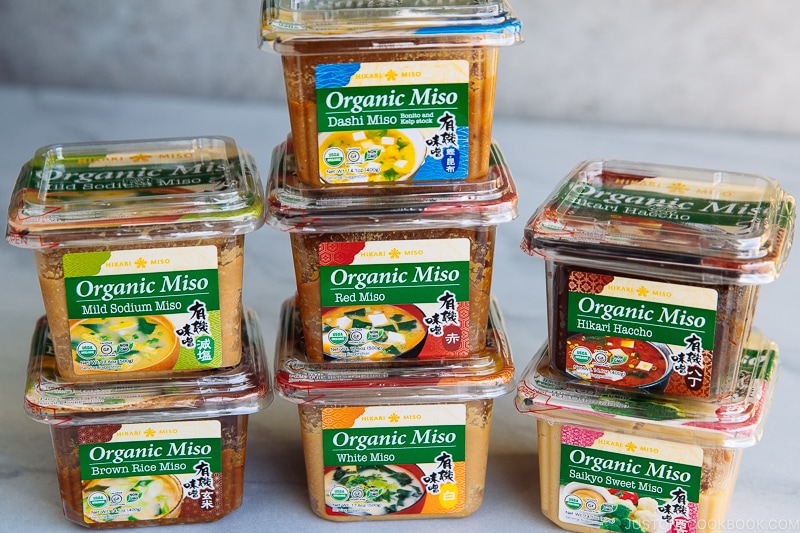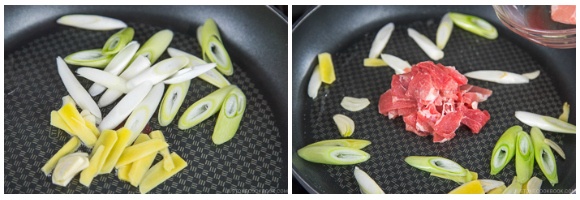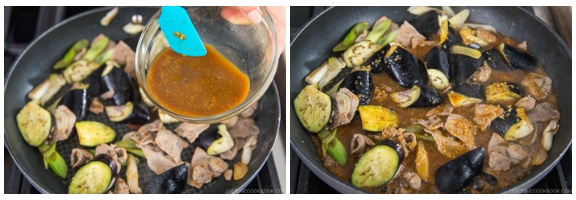This Miso Pork and Eggplant Stir-Fry recipe makes a delicious and easy weeknight meal. You‘ll love the magical combination of tender eggplants soaking up the savory miso flavors. Serve it as a main entree or a one-bowl meal over steamed rice.

Miso Pork and Eggplant Stir Fry (豚肉とナスの味噌炒め) is one of my go-to recipes when I have eggplants in my kitchen. I love the eggplants when they soak up all the delicious savory flavors, especially with miso and soy sauce-based sauce. When served over a bowl of steamed rice, the dish makes a satisfying dinner with affordable ingredients and is loaded with nutrition.
Table of Contents
3 Best Ingredient Combinations
The combination of miso and eggplant is fail-proof, and by adding pork, you get a robust and hearty stir-fry dish. If you use miso regularly, you’d agree that it makes an all-rounded seasoning that works with any protein, but my choice is always pork when I cook miso with eggplant. The absorbency of the eggplant and the sweet bold flavor of pork, when paired hand-in-hand, is one that you can rely on in various preparations. As a result, you get tender juicy pork, creamy eggplant, and a flavorful sauce that holds everything together. It’s a combination that works. Another delicious example you may want to try is this Ginger Pork Roll with Eggplant.
I used Japanese eggplant in the recipe. Japanese eggplant has a slender body and is more tender than other varieties. Since it cooks up quickly, it is the best choice for stir-frying and many other Japanese dishes. You can still substitute it with Chinese eggplant or another variety that you can find locally in your market. They are the freshest when they are in season.

Benefits of Cooking with Miso & Which Miso to Use
One of the most obvious uses for miso is in soup, but this fermented soybean paste has a lot more to offer. In Japanese cooking, you can find miso being utilized in marinades, vinaigrettes, and as a sauce to turn a plain dish into something incredibly flavorful. Not only it is a versatile seasoning for everyday dishes, it is also a mighty probiotic that offers many health benefits and essential minerals, and it is especially good for gut health.
If you’re new to Just One Cookbook, here are just some of the recipes featuring this all-purpose seasoning:
- Miso Yaki Onigiri
- Spicy Edamame
- Vegetable Miso Soup
- Miso Ginger Pork
- Spring Mix Salad with Sweet Miso Dressing

I’ve been cooking a lot of miso recipes this year using Hikari Miso, my favorite miso brand which I’m honored to partner with. Hikari Miso carries various types of miso that are organic and non-GMO. For this recipe, I’ve used Hikari Miso® Organic Miso – Red Miso, but you can use other types of miso to try out different flavors. You can purchase Hikari Miso from a majority of Japanese/Asian grocery stores or on Amazon.

Variations
Vegetarian/ Vegan-Friendly
Instead of meat, you can add tofu or deep-fried tofu such as Aburaage (deep-fried tofu pouch – no white tofu part) or Atsuage (thick deep-fried tofu with inside white and brown skin. You can find this variety at Asian grocery stores).
You can also keep it simple by using more eggplant. You can toss in other vegetables like zucchini if you like. Just remember that the cooking time will vary and the flavor profile may taste slightly different.
Some miso may contain dashi (it displays as だし入り “dashi included”) for your convenience to make miso soup instantly by adding miso into the water. Typically dashi is made of katsuobushi (dried bonito flakes) so if you plan to make vegetarian/vegan-friendly meals, make sure to pick miso that does not include dashi.
Make It Spicy
If you enjoy spicy food, I highly recommend adding a few teaspoons of Doubanjiang (chili bean paste) to your liking. If you enjoy just a little bit of spice like me, sprinkle some ichimi togarashi (Japanese chili pepper) or shichimi togarashi (Japanese seven spice).

Comfort Food at Its Best
Although the stir-fry dish is not particularly exciting looking, it’s truly comfort food, which is why I like to serve it over steamed rice. This one-bowl rice dish or what we call donburi, is a really easy weeknight meal for busy moms, singles, and students. Enjoy it with miso soup and a simple bowl of salad or green vegetable dish like Spinach Gomaae!

Wish to learn more about Japanese cooking? Sign up for our free newsletter to receive cooking tips & recipe updates! And stay in touch with me on Facebook, Pinterest, YouTube, and Instagram.

Miso Pork and Eggplant Stir Fry
Ingredients
- 2 Japanese or Chinese eggplants (or 1 globe eggplant)
- 1 Tokyo negi (naga negi; long green onion) (use the white part only; or use several green onions)
- 1 green onion/scallion (for garnish)
- 1 clove garlic
- 1 knob ginger (1 inch, 2.5 cm; peeled)
- 1 Tbsp neutral oil
- ¼ lb thinly sliced pork (I use komagire pre-cut pieces; buy pre-sliced at a Japanese grocery store or thinly slice meat at home and then cut into bite-size pieces)
For the Seasonings
For Serving as a Donburi Rice Bowl (optional)
- 2 servings cooked Japanese short-grain rice (typically 1⅔ cups (250 g) per donburi serving)
Instructions
- Gather all the ingredients.

- In a small bowl, combine 2 Tbsp miso, 1 tsp sugar, 1 Tbsp mirin, and 1 Tbsp sake. Mix all together until the miso is completely dissolved.

- Add 1 Tbsp soy sauce and 2 Tbsp water to the bowl. Mix well and set aside.

- Cut 2 Japanese or Chinese eggplants into bite-size pieces. I use the rangiri cutting technique to increase the surface area so it cooks evenly and adds more flavor. Soak the eggplants in water to prevent the color from changing.

- Meanwhile, thinly cut the white part of 1 Tokyo negi (naga negi; long green onion) diagonally. Cut the green part of 1 green onion/scallion diagonally into thin slices and set it aside for garnish.

- Slice 1 clove garlic and 1 knob ginger thinly.

To Stir-Fry
- Add 1 Tbsp neutral oil to a frying pan over medium heat. Cook the garlic and ginger until fragrant.

- Add the white part of the negi and ¼ lb thinly sliced pork.

- Stir-fry until the pork is 80% cooked through. Then, add the eggplant and stir-fry until it becomes slightly tender.

- Add the sauce and lower the heat to medium-low heat.

- Cook, covered, for 5 minutes. If there is not enough liquid/steam, add 1 Tbsp water.

To Serve
- When the eggplant is tender, turn off the heat. The Miso Pork and Eggplant Stir-Fry is now ready to serve. To serve it as a donburi rice bowl, divide 2 servings cooked Japanese short-grain rice into donburi (large) bowls and serve the stir-fry on top. Garnish with sliced green onion on top.









I enjoyed this recipe, but my dad kept complaining of the salt content (but he always complains about everything, so take it with–ahem–a grain of salt).
If it’s too salty for you (or if you’re making salted brown rice to go with, like me), try reducing your miso and shoyu by the tablespoon next time.
Hello, Aimee. Thank you for trying Nami’s recipe and sharing the images and experiences! 🤗
Making this tonight but I need to really bulk it up for my very hungry, bankrupting men. I’m increasing it and adding mushrooms and green beans from my garden. I have a pork loin roast. I was thinking of cutting it in think sticks. What do you think? Also, the technique of velveting meat to tenderize works great with beef. I might try that as well. What’s your thoughts?
Hello, Kathyleen! Thank you for trying Nami’s recipe.
Adding items from your garden sounds wonderful. Just a reminder that because the dish will hold more moisture, you may need to adjust the seasonings to balance the flavors. Please feel free to make more sauce as you need it.🙂
As for the meat, thin sticks would work for this dish. The texture would not be the same, but we hope you enjoy it!
Absolutely delicious! I made this once following the recipe almost exactly (I added sliced shiitake), and tonight I’ll be trying it with extra eggplant, extra sauce, and no pork, to be served alongside tonkatsu. I can’t wait!
Hi Cat! We are so happy to hear you enjoyed the dish.
Thank you for reading Nami’s post and trying her recipe! Happy Cooking!
Hi Nami. I really love your website, your energy and passion in sharing Japanese cooking and culture. I have a question on this recipe and perhaps eggplant / brinjal in general. My eggplant taste “raw”. I know if I put more oil to the cooking, it’s more cooked to the inside. I am wondering if you have any suggestions ? like do I need to cover and simmer the eggplant? Thanks.
Hello there, WeiLing. Thank you so much for trying Nami’s recipe and for your lovely thoughts about her.
Yes. You can cover the pan with a lid and cook the eggplant until tender. (See step 11)
We hope this helps you on your next try! Happy cooking!
Hello! I love this recipe but am also on the hunt for one of my favourite dishes that my Japanese mother cooks, a miso eggplant and green pepper stir fry, does Nami have a recipe for this also? Thank you! 😊 Jenny
Hi Jenny! Thank you so much for reading Nami’s post and trying her recipe!
Nami currently does not have a Miso eggplant and green pepper stir fry recipe, but what do you think of this stir fry Miso eggplant dish? Might this recipe be helpful? https://www.justonecookbook.com/stir-fry-miso-eggplant/
We hope this helps!
This is perfect – thank you! I’ll try it next time and experiment with what vegetable ratio works best. Looking forward to it!
Awesome! We hope you enjoy the dish! 🤗